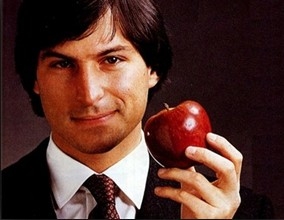CHAPTER SIX
第六章
THE APPLE II
Apple II
Dawn of a New Age
新時代的曙光
An Integrated Package
一體機
As Jobs walked the floor of the Personal Computer Festival, he came to the realization that Paul Terrell of the Byte Shop had been right: Personal computers should come in a complete package. The next Apple, he decided, needed to have a great case and a built-in keyboard, and be integrated end to end, from the power supply to the software. “My vision was to create the first fully packaged computer,” he recalled. “We were no longer aiming for the handful of hobbyists who liked to assemble their own computers, who knew how to buy transformers and keyboards. For every one of them there were a thousand people who would want the machine to be ready to run.”
喬布斯在個人電腦節的展廳考察了一番后,意識到ByteShop的保羅·特雷爾說對了:個人電腦應該以整套設備的形式呈現給消費者。他決定,下一代的蘋果電腦需要自帶一個漂亮的箱子和內置鍵盤,整合其他關鍵元素,從電源到軟件到顯示器。“我的想法是制造第一臺整合所有部件的電腦,”他回憶道,“我們的目標客戶不再是少數喜歡自己組裝電腦、知道如何購買變壓器和鍵盤的業余愛好者。希望電腦拿到手就可以運行的人,其數量是業余愛好者的1000倍。”
In their hotel room on that Labor Day weekend of 1976, Wozniak tinkered with the prototype of the new machine, to be named the Apple II, that Jobs hoped would take them to this next level. They brought the prototype out only once, late at night, to test it on the color projection television in one of the conference rooms. Wozniak had come up with an ingenious way to goose the machine’s chips into creating color, and he wanted to see if it would work on the type of television that uses a projector to display on a movie-like screen. “I figured a projector might have a different color circuitry that would choke on my color method,” he recalled. “So I hooked up the Apple II to this projector and it worked perfectly.” As he typed on his keyboard, colorful lines and swirls burst on the screen across the room. The only outsider who saw this first Apple II was the hotel’s technician. He said he had looked at all the machines, and this was the one he would be buying.
1976年的那個勞工節周末,在他們的酒店房間里,沃茲尼亞克在完善新一代機器的樣機——也就是后來的AppleII,喬布斯希望這臺機器能將他們的事業帶上一個新的臺階。這臺機器只被他們帶出過房間一回,是在某一天的深夜,他們將它帶到了一間會議室,連接上彩色投影電視進行測試。沃茲尼亞克有一個絕妙的想法,可以讓機器芯片運行出色彩,他想要看看這種方法在一臺使用投影儀顯示圖像的電視機上能否起作用。“我想,投影儀使用的色彩電路不同,和我的色彩生成方法一起工作的時候可能會發生錯誤,”他回憶道,“所以我就把AppleII連接到了這臺投影儀上,結果運行非常完美。”他在鍵盤上一番敲擊之后,彩色的線條和螺旋圖案就在屏幕上出現了。唯一一個見到AppleII的局外人是酒店的技術員。他說他見過所有的機器,但這一臺才是他愿意購買的。
To produce the fully packaged Apple II would require significant capital, so they considered selling the rights to a larger company. Jobs went to Al Alcorn and asked for the chance to pitch it to Atari’s management. He set up a meeting with the company’s president, Joe Keenan, who was a lot more conservative than Alcorn and Bushnell. “Steve goes in to pitch him, but Joe couldn’t stand him,” Alcorn recalled. “He didn’t appreciate Steve’s hygiene.” Jobs was barefoot, and at one point put his feet up on a desk. “Not only are we not going to buy this thing,” Keenan shouted, “but get your feet off my desk!” Alcorn recalled thinking, “Oh, well. There goes that possibility.”
要生產整套的AppleII需要大量的資金投入,于是他們考慮將股權出售給更大的公司。喬布斯去找了阿爾·奧爾康,希望能得到機會向雅達利的管理層進行推銷。奧爾康安排他與公司的總裁喬·基南(JoeKeenan)會面,此人相比奧爾康和布什內爾要保守許多。“史蒂夫進去向他推銷,但是喬根本無法忍受他,”奧爾康回憶說,“史蒂夫的個人衛生狀況讓他很不滿。”當時喬布斯光著腳,還一度把腳擱到了桌子上。“我們不光不會買你的東西,”基南吼道,“還要請你把腳放下來!”奧爾康回憶自己當時的想法:“完了,沒戲了。”
In September Chuck Peddle of the Commodore computer company came by the Jobs house to get a demo. “We’d opened Steve’s garage to the sunlight, and he came in wearing a suit and a cowboy hat,” Wozniak recalled. Peddle loved the Apple II, and he arranged a presentation for his top brass a few weeks later at Commodore headquarters. “You might want to buy us for a few hundred thousand dollars,” Jobs said when they got there. Wozniak was stunned by this “ridiculous” suggestion, but Jobs persisted. The Commodore honchos called a few days later to say they had decided it would be cheaper to build their own machine. Jobs was not upset. He had checked out Commodore and decided that its leadership was “sleazy.” Wozniak did not rue the lost money, but his engineering sensibilities were offended when the company came out with the Commodore PET nine months later. “It kind of sickened me. They made a real crappy product by doing it so quick. They could have had Apple.”
9月,康懋達電腦公司(CommodoreComputer)的查克·佩德爾(OiuckPeddle)來到喬布斯家中觀看他的演示。“我們打開了史蒂夫家的車庫門,讓陽光照射進來,查克走了進來,穿著西裝,戴著牛仔帽。”沃茲回憶道。佩德爾非常喜歡AppleII,他于數周后在公司總部為高層人員安排了一場演示。“你也許有興趣花幾十萬買下我們公司。”喬布斯到那兒后說了這樣一句話。沃茲尼亞克記得當時自己被這個“荒唐的”建議驚得目瞪口呆,但喬布斯堅持要這么做。幾天之后,康懋達公司打來電話說,他們認為研發自己的電腦更加省錢。喬布斯并不沮喪,他全面考察了康懋達公司后,認為該公司的管理層太“卑劣”了。沃茲尼亞克對于失去了這筆投資并不感到遺憾,但是當9個月后,該公司推出了他們自己的電腦“CommodorePET”的時候,他作為一名工程師,在感情上受到了極大的傷害。“那玩意兒讓我覺得惡心,”他說,“他們太急于求成了,所以做出這么一個蹩腳的產品。他們本來可以擁有蘋果的。”
The Commodore flirtation brought to the surface a potential conflict between Jobs and Wozniak: Were they truly equal in what they contributed to Apple and what they should get out of it? Jerry Wozniak, who exalted the value of engineers over mere entrepreneurs and marketers, thought most of the money should be going to his son. He confronted Jobs personally when he came by the Wozniak house. “You don’t deserve shit,” he told Jobs. “You haven’t produced anything.” Jobs began to cry, which was not unusual. He had never been, and would never be, adept at containing his emotions. He told Steve Wozniak that he was willing to call off the partnership. “If we’re not fifty-fifty,” he said to his friend, “you can have the whole thing.” Wozniak, however, understood better than his father the symbiosis they had. If it had not been for Jobs, he might still be handing out schematics of his boards for free at the back of Homebrew meetings. It was Jobs who had turned his ingenious designs into a budding business, just as he had with the Blue Box. He agreed they should remain partners.
對康懋達公司的這次出售未果也讓一直暗藏在喬布斯與沃茲尼亞克間的沖突浮出水面:他們對蘋果公司的貢獻真的一樣多嗎?他們之間的利益又該如何分配?杰里·沃茲尼亞克一直都認為工程師的價值要遠超過企業家和營銷人員,他覺得大多數錢都應該歸他兒子所有。喬布斯來家里作客時,杰里當面向他提出了自己的不滿。“你不配得到這么多他告訴喬布斯,“你沒有做出過任何產品。”喬布斯哭了起來,這在他身上是很常見的事情。他一直都不擅長控制自己的情緒——以后也不會擅長。喬布斯告訴沃茲尼亞克,愿意停止他們的合作關系。“如果我們不能對半分賬的話,”他對自己的朋友說,“你可以全部收為己有。”然而,沃茲尼亞克比自己的父親更加了解自己與喬布斯之間的共生關系。如果不是喬布斯的話,他可能還在家釀計算機俱樂部的會議上免費發放自己設計的電路板的原理圖,是喬布斯將他的技術工程天賦轉化成了蓬勃發展的生意,正如當年的藍盒子一樣。他同意繼續保持合作關系。











